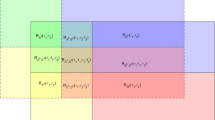Abstract
Distributed compressive sensing (DCS) has been used in multiple-input multiple-output (MIMO) radar system. This application has led to substantial improvements over existing methods in MIMO radar. But there are also some challenges that should be resolved in order to benefit the most from DCS-based MIMO radar, such as radar signal with low signal to noise ratio and optimizing measurement matrix design. In distributed DCS-based MIMO radar context, this paper presents a cognitive mechanism for optimizing transmit and receive gain by applying the optimization guideline which based on the coherence of the sensing matrix (CSM) and signal-to-noise ratio. This paper proposed two kinds of method: the first one is to optimize transmit gain with the aim to maximize SNR, and the second one is to minimize CSM by adjusting receive gain. Simulations show that the proposed methods obtain significant better recovery performance than traditional DCS-based MIMO radar systems.





Similar content being viewed by others
References
Haimovich, A. M., Blum, R. S., & Cimini, L. J. (2008). MIMO radar with widely separated antennas. IEEE on Signal Processing Magazine, 25(1), 116–129.
Li, J., & Stoica, P. (2007). MIMO radar with colocated antennas. IEEE on Signal Processing Magazine, 24(5), 106–114.
Fishler, E., Haimovich, A., Blum, R. S., Cimini, L. J., Chizhik, D., & Valenzuela, R. A. (2006). Spatial diversity in radars-models and detection performance. IEEE Transactions on Signal Processing, 54(3), 823–838.
Baraniuk, R., Steeghs, P., Baraniuk, R., & Steeghs, P. (2007). Compressive radar imaging. In IEEE on Radar conference, 2007 (pp. 128–133). IEEE.
Herman, M., & Strohmer, T. (2008). Compressed sensing radar. In IEEE on radar conference, 2008. RADAR’08 (pp. 1–6). IEEE.
Duarte, M. F., Sarvotham, S., Baron, D., Wakin, M. B., & Baraniuk, R. G. (2005). Distributed compressed sensing of jointly sparse signals. In Asilomar conference on signals, systems, and computers (pp. 1537-1541).
Chen, C. Y., & Vaidyanathan, P. P. (2008). Compressed sensing in MIMO radar. In 42nd Asilomar conference on signals, systems and computers, 2008 (pp. 41–44). IEEE.
Subotic, N. S., Thelen, B., Cooper, K., Buller, W., Parker, J., Browning, J., & Beyer, H. (2008). Distributed RADAR waveform design based on compressive sensing considerations. In IEEE on radar conference, 2008. RADAR’08. (pp. 1–6). IEEE.
Yu, Y., Petropulu, A. P., & Poor, H. V. (2012). Power allocation for CS-based colocated MIMO radar systems. In IEEE 7th Sensor array and multichannel signal processing workshop (SAM), 2012 (pp. 217–220). IEEE.
Yu, Y., Petropulu, A. P., & Poor, H. V. (2011). Measurement matrix design for compressive sensing Cbased mimo radar. IEEE Transactions on Signal Processing, 59(11), 5338–5352.
Gogineni, S., & Nehorai, A. (2011). Target estimation using sparse modeling for distributed MIMO radar. IEEE Transactions on Signal Processing, 59(11), 5315–5325.
Zhang, J., Zhu, D., & Zhang, G. (2012). Adaptive compressed sensing radar oriented toward cognitive detection in dynamic sparse target scene. IEEE Transactions on Signal Processing, 60(4), 1718–1729.
Grant, M., Boyd, S., & Ye, Y. (2008). CVX: Matlab software for disciplined convex programming.
Grant, M. C., & Boyd, S. P. (2008). Graph implementations for nonsmooth convex programs. Recent advances in learning and control (pp. 95–110). London: Springer.
Duarte-Carvajalino, J. M., & Sapiro, G. (2009). Learning to sense sparse signals: Simultaneous sensing matrix and sparsifying dictionary optimization. IEEE Transactions on Image Processing, 18(7), 1395–1408.
Stoica, P., He, H., & Li, J. (2009). New algorithms for designing unimodular sequences with good correlation properties. IEEE Transactions on Signal Processing, 57(4), 1415–1425.
Stoica, P., Li, J., & Zhu, X. (2008). Waveform synthesis for diversity-based transmit beampattern design. IEEE Transactions on Signal Processing, 56(6), 2593–2598.
Stoica, P., He, H., & Li, J. (2009). On designing sequences with impulse-like periodic correlation. IEEE on Signal Processing Letters, 16(8), 703–706.
Acknowledgments
This work is supported by China NSF Grants (61071163, 61271327,61071164, 61201367 and 61471191), the Fundamental Research Funds for the Central Universities (3082015NP2015504), and partly funded by the Priority Academic Program Development of Jiangsu Higher Education Institutions (PADA) and the Natural Science Foundation of Jiangsu Province under Grant BK2012382 and Funding of Jiangsu Innovation Program for Graduate Education and the Fundamental Research Funds for the Central Universities under Grant CXZZ12-0155.
Author information
Authors and Affiliations
Corresponding author
Rights and permissions
About this article
Cite this article
Liu, S., Zhang, G., Zhang, JD. et al. Transmit and Receive Gain Optimization for Distributed MIMO Radar. Wireless Pers Commun 85, 1969–1986 (2015). https://doi.org/10.1007/s11277-015-2885-1
Published:
Issue Date:
DOI: https://doi.org/10.1007/s11277-015-2885-1




